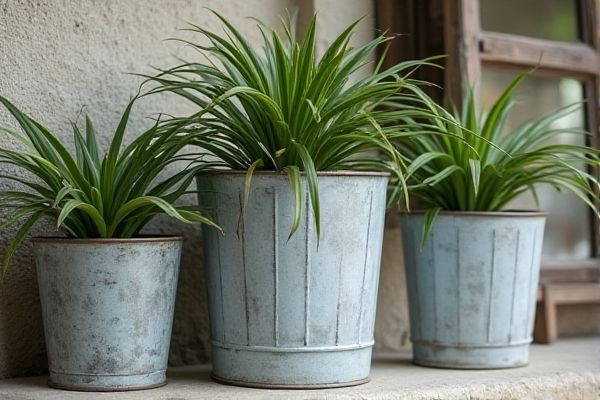
Galvanized planters offer durability and rust resistance, making them ideal for outdoor use, while ceramic planters provide an elegant aesthetic with excellent moisture retention for indoor plants. Discover how choosing the right planter can enhance Your gardening experience by exploring the detailed comparison in the rest of this article.
Table of Comparison
| Feature | Galvanized Planters | Ceramic Planters |
|---|---|---|
| Material | Galvanized Steel with Zinc Coating | Natural Clay or Porcelain |
| Durability | Highly Durable, Rust-Resistant | Fragile, Can Crack or Chip |
| Weight | Lightweight and Portable | Heavy and Less Portable |
| Drainage | Usually Pre-drilled Holes | Varies; Often Requires Manual Drilling |
| Weather Resistance | Excellent for Outdoor Use | Prone to Damage in Freezing Conditions |
| Insulation | Low, Can Heat Up Quickly | High, Protects Roots from Temperature Fluctuations |
| Maintenance | Low Maintenance, Easy to Clean | Requires Care to Avoid Chips and Cracks |
| Cost | Affordable to Mid-Range | Mid-Range to Expensive |
| Aesthetic | Industrial, Modern Look | Classic, Decorative Styles |
Introduction to Galvanized and Ceramic Planters
Galvanized planters offer durability and rust resistance through a protective zinc coating, making them ideal for outdoor gardening. Ceramic planters provide excellent moisture retention and a classic aesthetic, enhancing your plant's health and decor. Choosing between galvanized and ceramic depends on your gardening environment and style preferences.
Material Composition and Durability
Galvanized planters are crafted from steel coated with a layer of zinc, offering excellent resistance to rust and corrosion, making them highly durable for outdoor use. Ceramic planters are made from fired clay, which provides aesthetic appeal but is more prone to cracking or chipping under extreme weather conditions. Galvanized steel's longevity and weatherproof properties make it a superior choice for long-term durability compared to the more fragile nature of ceramic materials.
Aesthetic Appeal and Design Options
Galvanized planters offer a sleek, industrial aesthetic with a metallic finish that complements modern and rustic decor, while ceramic planters provide vibrant colors and intricate patterns suited for traditional and contemporary styles. Ceramic options excel in customization through glazed surfaces and artistic designs, enhancing visual appeal with textures and hues. Galvanized planters prioritize durability with minimalist designs, making them ideal for outdoor settings where weather resistance and understated elegance are desired.
Weather Resistance and Climate Suitability
Galvanized planters offer superior weather resistance due to their zinc coating, which prevents rust and corrosion, making them ideal for wet and humid climates. Ceramic planters, while aesthetically pleasing, are more prone to cracking in freeze-thaw conditions and may not withstand extreme temperature fluctuations as effectively. Choosing galvanized planters ensures durability and protection for your plants in harsh weather environments.
Weight and Portability
Galvanized planters are significantly lighter than ceramic planters, making them easier to move and reposition in gardens or patios. Their metal construction provides durability without the heavy bulk, which is common in ceramic planters due to their dense clay material. Lightweight galvanized planters offer enhanced portability for gardeners seeking flexibility in plant placement.
Drainage and Root Health
Galvanized planters provide excellent drainage due to their typically built-in drainage holes, preventing waterlogging and promoting healthy root growth. Ceramic planters, while aesthetically appealing, often have limited drainage options which can lead to root rot if overwatered. To maintain your plant's root health, choose a planter type that suits your watering habits and ensures proper soil aeration.
Maintenance and Longevity
Galvanized planters offer superior durability due to their rust-resistant coating, requiring minimal maintenance such as occasional cleaning to prevent buildup. Ceramic planters, while aesthetically pleasing, are prone to cracking and chipping, especially in extreme weather, and may need more frequent replacement or repair. The longevity of galvanized planters generally exceeds that of ceramic ones, making them ideal for long-term outdoor use with less upkeep.
Environmental Impact and Sustainability
Galvanized planters, made from steel coated with zinc, offer durability and resistance to rust but involve energy-intensive manufacturing and mining processes that impact the environment. Ceramic planters, crafted from natural clay, are biodegradable and less energy-consuming to produce but can fracture easily, leading to more frequent replacements and potential waste. Choosing sustainable planters involves weighing the long lifespan of galvanized options against the eco-friendly biodegradability and natural composition of ceramic alternatives.
Cost Comparison and Value
Galvanized planters typically offer a lower upfront cost compared to ceramic planters, making them a budget-friendly choice for large gardens or commercial use. Their durability and resistance to rust provide long-term value by reducing replacement frequency, while ceramic planters often come with higher initial costs due to their aesthetic appeal and fragility. Evaluating cost versus longevity, galvanized planters deliver greater value for practical use, whereas ceramic planters are preferred for decorative purposes despite potential higher maintenance costs.
Best Uses: Which Planter is Right for You?
Galvanized planters offer excellent durability and rust resistance, making them ideal for outdoor gardening and harsh weather conditions, while ceramic planters provide superior breathability and aesthetic appeal, perfect for indoor plants and decorative settings. For heavy or large plants requiring robust containers, galvanized options deliver strength and longevity, whereas ceramic planters excel in maintaining soil moisture for delicate houseplants. Choosing between galvanized and ceramic planters depends on your specific needs regarding environment, plant type, and desired style.
 homyna.com
homyna.com